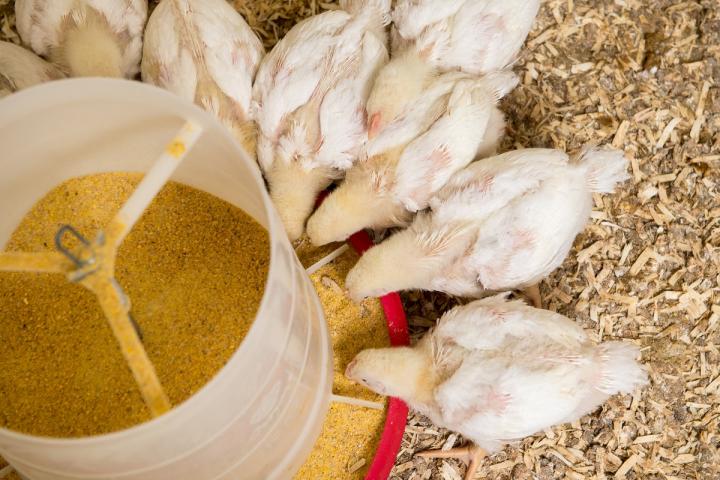Findings could improve both animal and human health, providing insights into liver and metabolic disease in animals and humans

Credit: Edwin Remsberg, University of Maryland
Nishanth E. Sunny, assistant professor in Animal and Avian Sciences (ANSC) at the University of Maryland (UMD), is leading a team to improve poultry production by examining the mysteries of embryonic and new-born chickens, with a long term goal of improving both animal and human health. The first week after hatch is a major indicator of how healthy a chicken will be and how well the bird will grow, and it is during this time that the birds undergo a dramatic metabolic switch, from the fat-rich diet the embryos grow in, to a high carbohydrate diet. This is a natural and healthy transition for most chicks, whereas a high fat diet in several species and humans leads to serious metabolic consequences such as fatty liver disease and Type II diabetes. By understanding this metabolic transition that is so critical for healthy and efficient poultry production, researchers can not only optimize nutrition to make that transition as smooth as possible, but also gain insights into how the liver works to help prevent metabolic disease in other animals and humans.
“When you think about the egg, it basically consists of yolk, which is a ball of fat and proteins, surrounded by the egg white,” explains Sunny. “So when an embryonic chicken is in the later stages of development inside the egg, it relies on the egg yolk for energy and rapidly accumulates fat in the liver. Why that’s interesting is that accumulation of fat in humans and other mammals like mice is related to metabolic disease. But in embryonic chickens, they never seem to develop these issues. They are very efficient in using the yolk lipids, metabolizing it, and generating energy. The goal of this new grant is to understand how the liver of the embryonic chicken uses all those fatty yolk nutrients without the generation of toxic lipid byproducts or disease, by understanding the metabolic transition in chickens.”
Tom Porter, professor in ANSC at UMD, is a co-investigator with Sunny on the new grant from the United States Department of Agriculture National Institute for Food and Agriculture (USDA-NIFA), bringing his years of experience studying poultry physiology and genetic expression to the table. Porter has previous USDA-NIFA funding to examine the genetic mechanisms of the metabolic switch from embryos to hatchlings. This switch has implications for the welfare of the chick, as well as its growth potential.
“About 1-2% of chicks are given everything they need post-hatch, but they just never grow,” says Porter. “While that sounds like a small amount, when you think of the scale of the industry, this translates to millions of birds a year that could be performing much better, but instead aren’t really growing even with the same amount of feed, time, and resources.” In fact, according to the USDA, over 9 billion birds were produced in 2019, meaning upwards of 90 to 180 million birds each year are affected.
Sunny brings unique expertise to this work as the lead investigator, largely due to his training as both an animal scientist and a medical researcher. In fact, Sunny has an ongoing grant with the National Institutes of Health (NIH) examining similar aspects of liver function in mice as a model for human disease.
“The main objective of this USDA-NIFA grant from an animal science perspective is to primarily understand that metabolic transition for chickens, especially how the liver is functioning and staying healthy,” says Sunny. “If we understand what the liver is doing, we can use nutritional or pharmacological approaches to fine tune that transition and make it as smooth as possible for the chickens. But the second goal, which is very interesting to me, is using that as an opportunity to understand more aspects of how the liver works to prevent and treat metabolic disease in humans and other species.”
Sunny is specifically bringing innovative techniques not commonly used in chicken models into this work, including using tracer molecules (called stable isotopes) to track biochemical pathways so that the mechanisms of this metabolic transition can truly be understood. The biochemistry that Sunny is most interested in is that of the liver mitochondria, known as the powerhouse of the cell and used to create most of the organ’s energy.
“Nowadays, with all types of diseases – metabolic, psychological, you name it – every disease has a mitochondrial dysfunction component because of its role in maintaining the energy balance of the cell,” says Sunny. “So from a liver perspective, we want to know how the mitochondria in these embryonic and newly hatched chickens are able to take on all that fat or lipid overload and use it efficiently without any associated abnormalities.”
As Sunny explains it, studying the mitochondrial metabolism is a tricky process, and one that hasn’t been widely done in chickens. By combining his expertise in advanced biochemical techniques to study the mitochondria with Porter’s previous work profiling the expression patterns of genes in chickens, researchers can finally paint a full picture of what is going on during this transition and how it relates to healthy or abnormal liver function.
“Because of the lack of advanced techniques used in the study of the embryonic to post hatch transition in chicks, the majority of the research done in those models and the conclusions are based on gene expression profiles,” explains Sunny. “Conclusions made without accounting for changes in biochemical pathways could be incomplete because you are making assumptions and can’t accurately track the mechanisms involved. We want to get a more complete picture and see how previous research holds up.”
Sunny says he owes this work to his mentor and doctoral advisor, Brian J. Bequette. Bequette was a professor at UMD, and actually trained Sunny in the same lab in ANSC that is now his lab today. Bequette was one of only a few animal scientists nationwide at the time that was practicing the advanced biochemical techniques used in this grant, and he taught them to Sunny, which got him a postdoctoral fellowship at the University of Texas Southwestern Medical Center after graduating in 2008. After studying fatty liver and metabolic disease in humans and rodent models for years, Sunny was all too happy to return to UMD and expand the scope of his work to chickens once more.
“If I had continued on at the other medical schools, this grant would not have happened, because they don’t want you to study chickens,” says Sunny. “So even though I had this idea, I couldn’t do anything about it until I came here. After talking to Tom [Porter], who was actually on my PhD committee, I brought up collaborating and looking at the metabolism and mitochondrial function in chickens. Being at UMD gives me the ability to do both medicine and animal science to get a more complete picture of metabolism across species. Bequette and the training at a prestigious medical school gave me the tools to do it in a more sophisticated way, but the animal science department at UMD gave me the opportunity. It still makes me kind of nostalgic to think how the whole cycle worked out for me, now running the same lab where I was trained.”
###
This work is funded by the United States Department of Agriculture National Institute for Food and Agriculture (USDA-NIFA), Award # 2021-67015-33387.
Media Contact
Samantha Watters
[email protected]
Original Source
https:/




